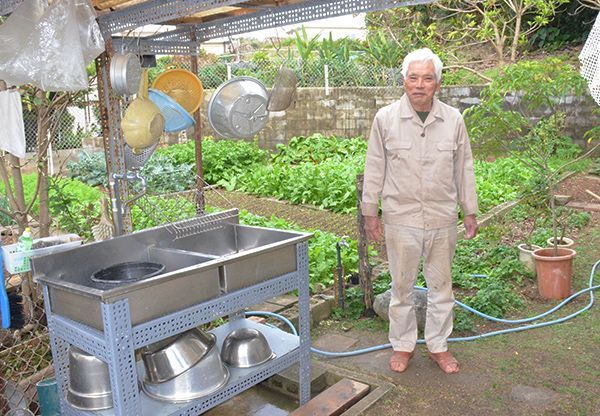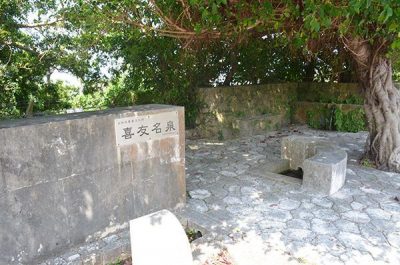Residents near MCAS Futenma concerned by high concentrations of PFOS/PFOA in water, U.S. military refuses on-base investigation

Kousei Gushiken says, "I'm scared to spray the water on my plots." The faucet to the left is a convenient watering tool, but now he only uses it for washing his hands and such. This photograph was taken in February 2019 on Gushiken's property in Kiyuna, Ginowan City.
April 12, 2019 Ryukyu Shimpo
By Maki Nagamine
Perfluorooctane sulfonate (PFOS) and perfluorooctanoic acid (PFOA), the use of which chemicals is principally prohibited within Japan, have been detected at high concentrations in spring water and other water sources in the vicinity of the Marine Corps Air Station Futenma (MCAS Futenma).
Residents of Ginowan City are expressing their uneasy feelings at this. The U.S. military is not allowing examinations within the base compound, and there are no signs that this situation will improve.
Once the chemicals were detected, some residents stopped using the water on their agricultural plots. Some people are calling for the Ginowan City Assembly to put more pressure on Japan and the U.S. to conduct an investigation into the cause of the contamination and clean the water.
This movement is growing in the city.
The OPG has been conducting investigations in the vicinity of MCAS Futenma two times each year since 2016, and it detects high concentrations of PFOS and PFOA downstream of the base each time.
Due in part to a foam fire extinguishing agent used on the air station in the past, the Okinawa Prefectural Government (OPG) expressed its opinion that, “It is exceedingly likely that it came from Futenma Air Station.”
PFOS and PFOA are likely carcinogens. Although Japan has no environmental standard value concerning concentrations of PFOS and PFOA, in the U.S. the Lifetime Health Advisory Level (HAL) is set at 70 nanograms per liter (ng/L) of drinking water.
Concentrations greatly exceeding this level are frequently detected in the drinking water in Ginowan City. In August and September last year, 2,000 ng/L were detected in Kiyuna’s Chunnaga Fountain. The OPG said, “If it is not directly consumed, it will not be an issue to people’s health.”
Even if it is said to be fine…

The Chunnaga Fountain (Kiyuna Spring) has supported area residents’ lives since before WWII, and has become an object of faith.
Kosei Gushiken, 85, voiced his concerns: “No matter how many times it is said to be fine, it still concerns me. I cannot give the vegetables I’ve grown to my grandchild.”
Gushiken has been cultivating about 20 types of crops in Kiyuna over the course of more than 40 years.
Kiyuna residents used to make round trips to and from Chunnaga to carry in water before the war, and in 1957 they laid pipes to conveniently bring in water from Gaa. According to concerned persons, over 100 households still use this pipe system.
However, PFOS and PFOA contamination was detected about three years ago. Gushiken stopped watering his plots with the contaminated water, and now only uses it when he washes his hands or agricultural equipment. He said, “The U.S. military or the Ministry of Defense should remove the contaminants.
Can’t the city and prefecture demand this more firmly?”
High concentrations of PFOS and PFOA continue to be found, even in spring water in the Oyama region where taimo potatoes are produced, a Ginowan specialty.
One time when the OPG conducted an investigation in 2016, the contaminants were not detected in the taimo.
Still, there is deep-seated concern in the region about the extent of the damage.
One 55-year-old man from Oyama who has been cultivating taimo for about 20 years said, “Regardless of the levels, there is no doubt [the chemicals] are toxic. The U.S. military should remove [the contaminants].”
He went on to request that the OPG conduct periodic examinations on the taimo and make the results public.
Also, he is calling for it to collect water for use in one place, and purify it to do away with contaminant damage.
Ginowan as a Concerned Party
Whenever the Ginowan City Assembly has a regular meeting it receives many questions about how Ginowan will handle the situation. People make calls for stronger actions such as, “I want stronger demands to the U.S. military to restore our water to its original state,” and “We should conduct a fact-finding survey, ourselves.”
Contrary to these calls, the city is prioritizing the OPG request that Japan and the U.S. military establish of a place for concerned parties to coordinate, and repeatedly responds, “We want to steadily develop this request.”
The Assembly called for the U.S. military to provide information concerning PFOS and PFOA. Yet in regard to the origin of the contaminants, the Assembly stated its perception that it is difficult to specify a particular region as the source and made no reference to MCAS Futenma.
Again in December last year, Ginowan sought an explanatory meeting about contamination from the Kiyuna Neighborhood Association.

However, the Association did not hold the meeting, giving its reason that the OPG is conducting the bulk of the investigation. Hideaki Chinen, 45, an official of Kiyuna Ward and a Ginowan City Assembly member, said, “It is difficult for the ward [Kiyuna] to directly appeal to the U.S. military and Japan.
I want to work more closely with city residents.”
In October last year the research group called the Informed-Public Project (IPP) submitted a statement titled “Questioning Ginowan City’s Status as a Concerned Party” to Ginowan City.
Having discussed with experts, city residents and others, the IPP is demanding a fact-finding survey including actions such as defining the scope of contamination and discussing appropriate concentration levels.
IPP Director Masami Kawamura pointed out, “Accumulated contaminants are currently oozing off of the base, so this should be dealt with as soon as possible.
Because the site of the former base will be used in the future, the city must also make a request to the U.S. military, and pursue countermeasures on the base.”
Concerning investigation into the contamination, Kawamura said, “If it is going to be called safe, entities such as the city and prefecture must at least investigate. The OPG has only examined Oyama’s taimo once, which is far from adequate.”
(English translation by T&CT and Erin Jones)
Previous Article:The three participating parties at a summit to reduce the base burden agree to set new deadline for closing MCAS Futenma
Next Article:Okinawa Shogaku Junior High School receives MEXT Minister Prize for largest number of Eiken passers
[Similar Articles]
- Kyoto University professors detect PFOS concentration of 4 times national average in Ginowan residents’ blood
- Record high concentrations of PFAS detected in groundwater around Kadena Air Base
- High levels of PFOS detected in Kin Town, the highest level at site adjacent to US base
- OPG finds high PFOS concentrations near Kadena Air Base, advises against drinking the water
- Japanese government knew of Kadena Air Base’s PFOS contamination, did not disclose it
 Webcam(Kokusai Street)
Webcam(Kokusai Street)


